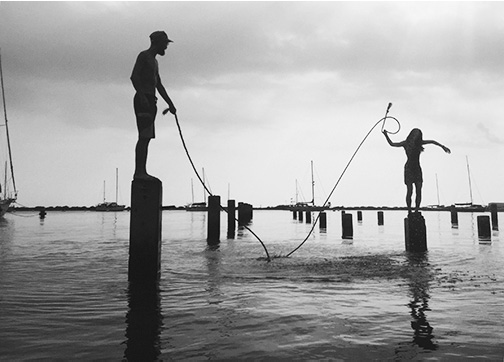
FLOOD / TURN THE TIDE
first performed on June 20, 2015
the streets of Kaka‘ako, Honolulu, HI
performed four times in 2015
BODY PORTAL THEATRE / SHEENRU YONG, E. SPENCER AGOSTON
Honolulu, HI / Taipei, Taiwan
539628062i539628062n539628062f539628062o539628062@539628062b539628062o539628062d539628062y539628062p539628062o539628062r539628062t539628062a539628062l539628062t539628062h539628062e539628062a539628062t539628062r539628062e539628062.539628062c539628062o539628062m
bodyportaltheatre.com
FLOOD / TURN THE TIDE
BODY PORTAL THEATRE / SHEENRU YONG, E. SPENCER AGOSTON
“FLOOD / turn the tide” was a project designed to create island-wide conversations about water. It evolved into a series of workshops, events, interviews, and site-specific performances piloted and conducted in Myanmar, Taiwan and Hawaii. In Hawaii, where water is the organizing principle of its culture, it became impossible to create a relevant response in a black box, proscenium stage, or studio.
We started dancing outdoors, and performed in four different locations: tracing the path of a paved over natural spring in a rapidly developing neighborhood, on the bank of a channelized stream bordering Hawaii’s biggest university, at a pristine private beach, and in the middle of an active harbor on 25 x 25 cm posts leftover from the 2011 tsunami in Japan that stripped a pier of its deck.
Each performance was a different response to the body of water, terrain, and histories of the site. The audience ranged from passersby to invited dance critics; some sites were welcoming, sometimes we were asked to leave. Due to the unpredictable natures of these sites (i.e. a week of storms changed the face of the river entirely), a few of these performances were largely improvised structures of tasks: alter & unalter the environment / listen to the water in the air / follow the most efficient path which is not direct.
In the one-time culminating performance, “where water meets land,” audiences were bussed to an undisclosed location (we could not get formal permission). On the way, they listened to an audio track created from interviews about water. Arriving at a convergence of land-sea, harbor-airport, development-dilapidation, patrons of the arts and local inhabitants of a neglected neighborhood gathered on the shore. From a distance, they watched performers poised on posts, backed by a setting sun, moving sea vessels, and planes taking off. With pollution rendering the water unsafe to fall into, the six dancers and two musicians negotiated the constantly changing elements: waves, wind, rain, sun, and sea animals before being pulled in by the audience on a remnant of the dock.
Built or found environments changed the language of our movements. Dance became not about moving on a stage, but about being moved by the environment, by its natural and human-made histories. In both subject matter and execution, FLOOD became a reckoning of perspective, seeing and staging ourselves in relation to that which is far bigger than us.